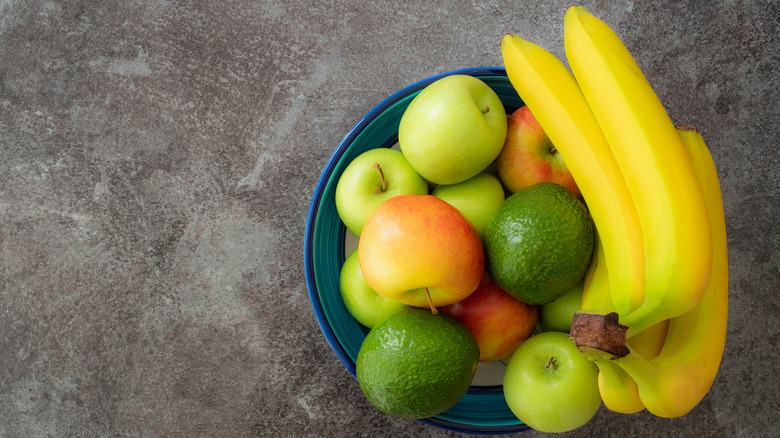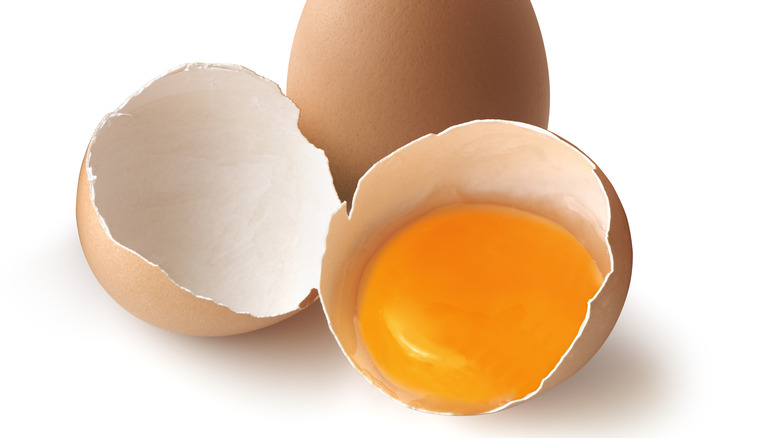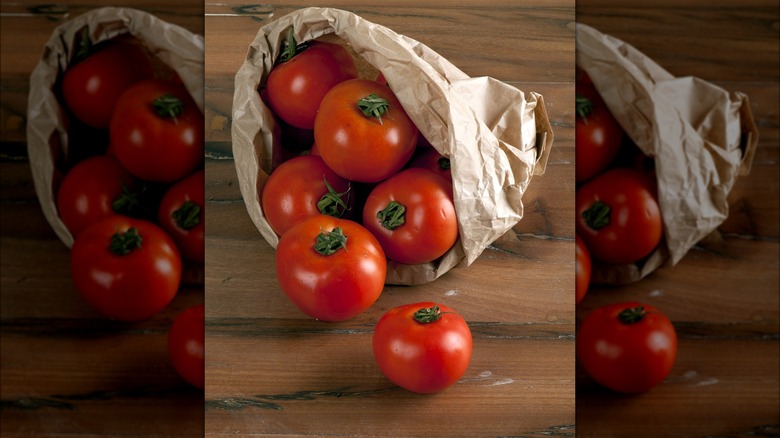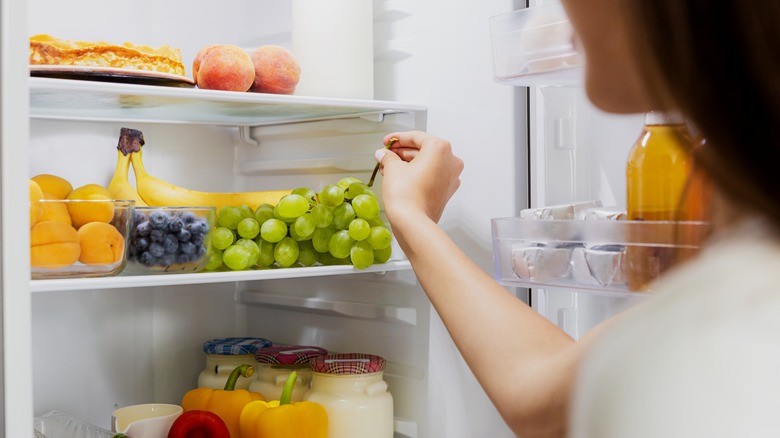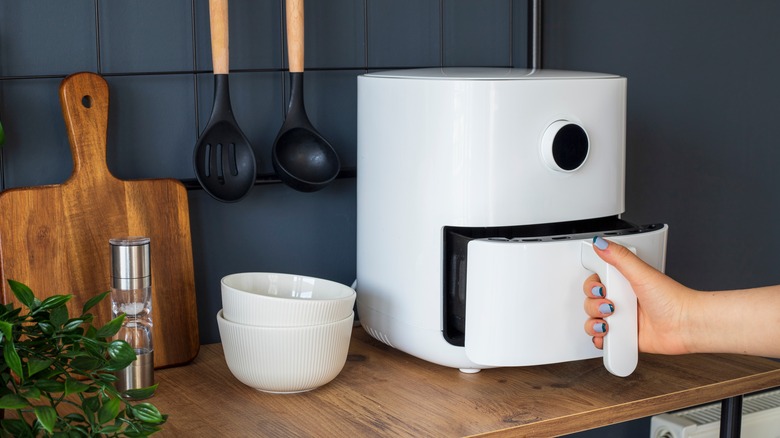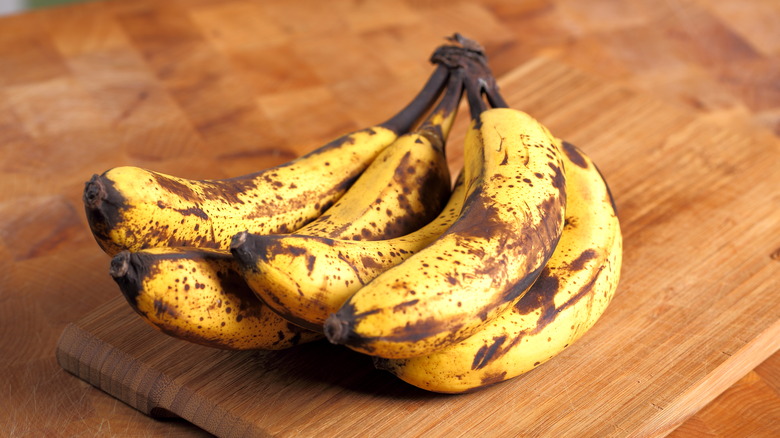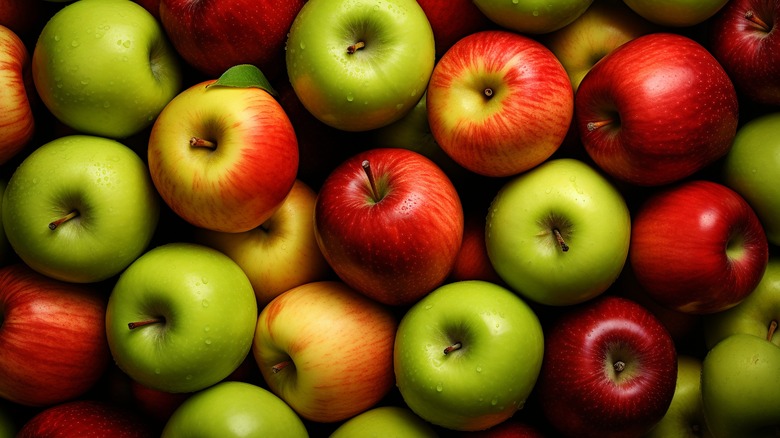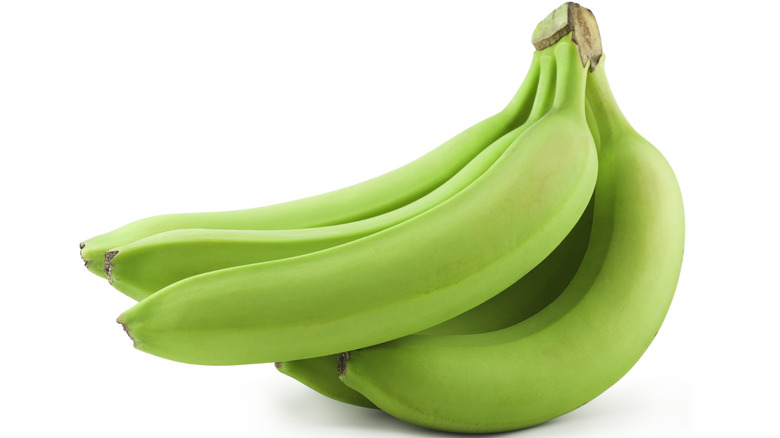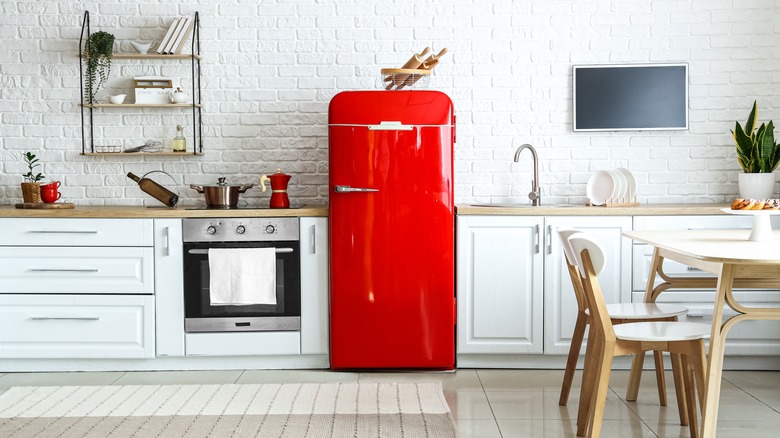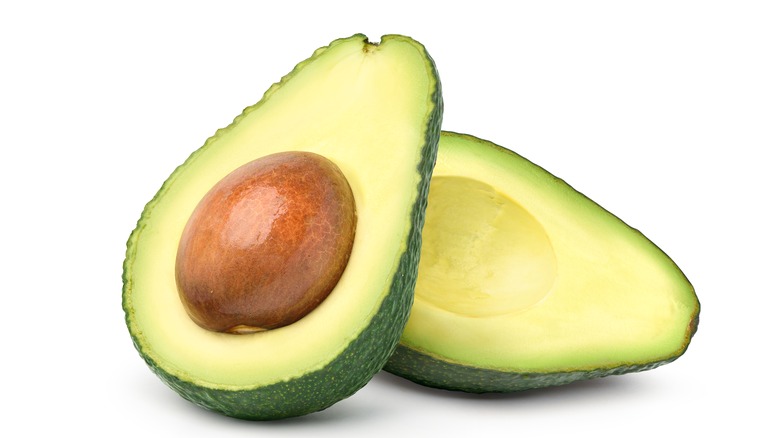10 Hacks That Will Help Ripen Fruit Much Faster
On a typical Tuesday, you might ripen your fruit by taking it out of the packaging or bag and wait until it softens or darkens to the appropriate level for your recipe or for general consumption. But this process can take days, and who wants to wait that long when they have a hankering for banana bread or peach cobbler? Making one of these desserts with unripe fruit is going to yield a far less sweet and tasty result than you'd otherwise get. The same is true for produce you might want to bite into on its own. Eating an unripe avocado, for instance, means to miss out on all the pleasures this fruit can provide.
But what if we told you there was a way to hurry along the process, so that next time you want to make banana bread on a Tuesday, you don't have to wait until Friday? To ripen fruit effectively, understanding its unique characteristics is key. Many fruits, such as bananas, avocados, and tomatoes, release ethylene gas as they ripen, which triggers the softening and sweetening process in them and surrounding fruits. This natural agent can be harnessed to accelerate ripening by placing fruits together in an enclosed space. Additionally, exposure to warmth and sunlight can expedite ripening.
Although artificially rushing the process can compromise the taste, texture, and nutritional content of the fruit, it can certainly help out when you're in a bind. Let's take a look at how to get that done.
1. Surround fruit with rice
You may have heard of surrounding your phone with uncooked rice after accidentally dropping it in the sink. Since rice absorbs moisture, this method is meant to literally pull the water out of the phone, drying it from the inside out. The concept of surrounding unripe fruit with rice works in a slightly different way. In this case, the rice grains help trap the ethylene gas that fruits release as they ripen, keeping it in the fruit so that it doesn't disperse into the air. With this gas hanging around for longer, the fruit will ripen a few days faster.
The technique involves enclosing your chosen pieces of fruit in a sealed container with plenty of rice. Be sure to check the container every day and take the fruit out before the ripening goes overboard. And don't forget to store this container in a dry and room-temperature space. Otherwise, too much moisture will end up getting into the rice because, as you may remember, those grains absorb moisture like it's nobody's business — and moisture could cause your fruit to rot before it ever even ripened.
2. Mash unripe bananas with raw egg yolk
When you want to make a banana-based recipe, but you only have unripe fruits, you can artificially ripen the whole banana with a number of handy tricks. Most of these will get your bananas ready to use a few days earlier than normal. But if you don't have all that time and want to get going on your recipe right now, you can use a raw egg yolk trick that involves peeling the banana and getting to work on its pulp from the get-go.
So let's say you have a bunch of bananas that you just brought home from the grocery store. Chances are that they are still lime-green or pale yellow and hard to the touch — not the right conditions for cooking with bananas. Indeed, one of the major benefits of using this fruit is its amylase content, which is what creates those sweet and sticky qualities that work so well in banana bread and other baked goods. As the fruit ripens, the amylase converts the banana's starches into sugar. As it happens, egg yolks are also high in amylase, which is one reason why they're required in practically every baked good you've ever made (and why bananas can be used as egg substitutes).
To ripen a banana faster then, just mash 8 ounces of the fruit with two raw egg yolks. In about 30 minutes, the amylase will have done its job, and the banana will be soft and sweet.
3. Pile fruit into a paper bag
When you get home from the grocery store or farmers market, you may be accustomed to removing your tomatoes, peaches, or other produce from the bag in which they were stored. Removing them and airing them out can help them ripen slowly and naturally while minimizing the risk of those dreaded mold spots. But the calculation changes when you're trying to ripen fruits faster — as in the case of tomatoes. You may want to simply leave those tomatoes in the bag, regularly peeking in at them to ensure they're not growing any mold.
That's because closing the fruits in a paper bag will trap that famous ethylene gas they release as they ripen in there with them. This will hasten the ripening process as the starches break down and the sugar takes hold. The same is true for peaches, which tend to be picked long before they've had a chance to ripen on the tree. Soft, ripe peaches would not hold up well in transit. In both cases, be sure to use a paper bag rather than plastic or glass containers. Paper will allow the fruit to breathe and trap in the ethylene gas but not the moisture — the latter can quicken the development of mold.
As for ripening times, expect your paper-bagged tomatoes to be ready in a few days or up to two weeks, depending on how underripe they were to begin with. With peaches, you may only need two days.
4. Keep unripe fruit out of the fridge
Many people place all sorts of foods in the refrigerator out of an abundance of caution. The cold environment is meant to stay the decay process, leaving items fresher for longer. And what could possibly be wrong with that? Generally speaking, nothing at all. But if you're dealing with fruit, and especially fruit you want to ripen faster, the fridge is going to be your enemy. In short, it's best to never refrigerate underripe fruit.
This is because those same cold temperatures that ward off the growth of bacteria in your food will also prevent ethylene gas, which is necessary for ripening, from acting, thereby interfering with the proper ripening process. To ripen fruit naturally, it's always best to leave it at room temperature. Only after it's achieved its ideal state of ripeness is it okay to place the fruit in the fridge.
But remember that this is only true of climacteric fruits, as is fruit that continues to ripen even after it's been picked. Peaches, tomatoes, avocados, and bananas are some items that fall into this category. Non-climacteric fruit like grapes, cherries, or watermelons can be stored in the fridge without incurring damage.
5. Toss bananas in the air fryer
Air fryers seem to be able to do just about anything in the kitchen nowadays. You can use them to make healthy and easy recipes as varied as roast beef, fried shrimp, and baked sweet potatoes. You can also use air fryers to quickly ripen your bananas. That's because the circulating hot air that defines the air fryer's cooking process can also speed up a banana's natural ripening without actually cooking it (as long as you don't leave it in there too long).
The key is to place them in a warm environment, so we recommend preheating the air fryer to 300 F and inserting your semi-ripe bananas with their peels on — anything too green might not take with this method. For best results, line your air fryer basket with aluminum foil or parchment paper and lay the bananas in a single layer before heating them up until the peel turns dark brown — this should take about eight minutes. The dark brown color is your clue that the inside of the banana has turned soft and sweet.
6. Place a ripe banana next to other fruit
Ripening a green or pale yellow banana can be a bit of a process, but if you already have a ripe banana and need to get to work on another type of fruit, then the job couldn't be easier. Indeed, bananas are so rich in ethylene, the gas that causes fruits to ripen, that they're practically bursting with it. That is to say that bananas have it to spare, and that's exactly what happens when you place a ripe banana next to another type of fruit that can ripen off the vine. That piece of fruit falls under the spell of the banana's ethylene and turns ripe itself.
You can use this method by placing everything in a paper bag, which will speed up the process, or out on your counter, as long as the banana is in close proximity to the other fruit. Of course, be aware that if you're trying to keep your fruit from ripening, or if you're concerned about it getting moldy, then you'll need to keep your bananas well clear of it.
7. Store fruit with an apple
Storing underripe fruit with bananas will help speed up the ripening process, but this effect is also true of apples. So if you happen to be short on bananas on any particular day, just swap in some apples instead. And if you don't believe us, just think about the old adage, "One bad apple spoils the lot." The same process that creates spoiling — the release of ethylene gas — is also what ripens fruit. So if you put one ripe apple with that fruit, the lot will also ripen. This is especially true if you use McIntosh apples, which according to The University of Maine, produce even more ethylene than other types of apples.
The best way to use this method of ripening is to whip out that paper bag and place the ripe apple inside along with the fruit you want to ripen. Just make sure you keep that old adage in mind. It doesn't take long for a ripe apple to turn into a bad apple, and you wouldn't want to accidentally spoil your whole bag of fruit due to neglect. While it may take several days for your fruit to ripen this way, it's best to check it at least once a day to make sure nothing has gone awry.
Also be sure to avoid trying this trick on fruit that cannot ripen further off the vine, like grapes. If you do this, the fruit may go straight to spoiled.
8. Ripen bananas in the oven
There are a lot of different ways to speed up the ripening of a banana, some of which require specialized equipment like an air fryer. But if you don't have any fancy kitchen tools, you can always use your oven. While this may take you a little longer — between the preheating and the time it takes for the banana to heat up — it will still be faster than waiting several days for your banana to ripen naturally.
For this trick, you'll need to lay the unpeeled bananas on a lined baking sheet while you preheat the oven to 300 F. Make sure the bananas are not touching. Then simply bake them for 15-30 minutes, depending on how ripe you want them and how ripe they were to begin with. This method is especially helpful if you're working with a large quantity of bananas, as the oven tends to have more space than air fryers or microwaves. Also, be sure to let the bananas cool before you start working with them, or you might have some trouble removing those scalding hot peels from the pulp.
9. Place unripe fruit on top of your fridge
If you've ever noticed that your apples or pears tend to ripen faster in the summer than in the winter, then you may have figured out that heat can be a factor in helping fruit ripen. And while it is possible to ripen bananas faster by placing them in a very hot environment like an oven, air fryer, or microwave, you don't necessarily have to go to such extreme measures, especially if you're not in a mad rush.
For instances like these, where you have a bit more time at your disposal, it's enough to place your fruit on top of your refrigerator instead of on the counter near it. Counterintuitively, refrigerators can be warm on the outside despite being cold on the inside. This is because it is an electric appliance, after all, so the machine that runs it must produce heat somewhere. And since the fridge is always on, the heat is always emanating. One place where that manifests is on the top. If this space is a no-go in your household for whatever reason, you can achieve a similarly mild warmth by placing your fruit in direct sunlight, near a radiator, or close to another working appliance.
10. Microwave your underripe avocados
Avocados are a hugely popular food these days, but they're also extremely temperamental. An underripe avocado is bland, hard, slippery, and unpleasant to bite into. But wait just half a day too long to cut into this fruit, and you'll be left with a mushy mound of brown goo. The key to consuming avocados and drawing maximum enjoyment from them is finding them at their peak performance, a very small window that usually lasts about a day or so.
To avoid having to deal with any ripening surprises, take control by ripening avocados in the microwave. This process is a little more involved than letting the fruit do its thing, but it will only take about three minutes of your time. Just slice the avocado in half, wrap both halves in plastic wrap to keep the ethylene near the fruit and therefore more effective, and microwave them in 30-second intervals. Be sure to check on them every time to make sure they're getting softer but not too soft.
That said, this method can lead to not only an inconsistent texture, but also slight temperature differences across the ripening avocado — meaning some spots may become softer than others. You also may have to forgo the avocado's signature buttery flavor in the interest of speed. But these differences shouldn't be too noticeable if you're using the avocado to mash into guacamole.
Static Media owns and operates Tasting Table and Mashed.
